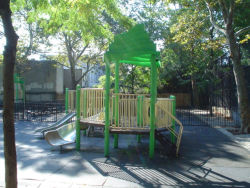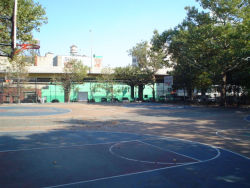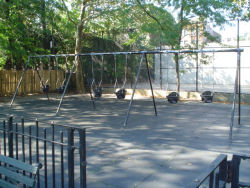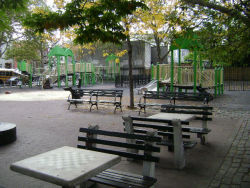Washington Hall Park
Washington Hall Park
This park, located on the north edge of the Clinton Hill section of Brooklyn, was originally acquired as part of the widening of Park Avenue. It was acquired through property condemnation in 1942 during the administration of Mayor Fiorello H. LaGuardia and Commissioner Robert Moses. It was named Washington Hall Park, for its three boundary streets, by Commissioner Stern in 1987. Laid out in 1835, Washington Avenue honors George Washington (1732-1799) commander in chief of the Continental Army and first president of the United States (1789-1797). Hall Street, also mapped in 1835, is believed to have been named for George Hall (1795-1868), first Mayor of the City of Brooklyn. Hall, a painter and glazier by trade, served as mayor for one year upon the adoption of a municipal charter in 1834, and was elected to a two-year term as mayor in 1855, at the time when Williamsburgh and Bushwick were annexed to the City of Brooklyn.
The original playground, designed by W. Earle Andrews in 1942, used standard features for that time, including a sandpit, children’s swings, see-saws, wading pool and play equipment, two basketball courts, and a handball court. In the late 1950s an elevated section of the Brooklyn-Queens Expressway was erected along Park Avenue, the park’s northern boundary. South of the playground lies the Clinton Hill Historical District. Designated a historic landmark district in 1981, and named for Mayor and United States Senator DeWitt Clinton (1769-1828), the community has a rich architectural history characterized by four distinct eras of development: Gothic and Italianate villas in the 1840s, brownstone rowhouses between the 1860s and 1880s, a second wave of mansions from 1880 to 1915, and garden apartment buildings from the 1920s to 1940s.
Washington Hall Park was rebuilt in 1997, and its new design incorporates many woodland elements. Two spray showers are made of cast-concrete otters, and the surrounding area has flora and fauna such as lily pads, cattails, butterflies and fish etched into the paving. A simulated dry river bed of beige concrete leads visitors to a newly planted area beside the renovated public restroom. Here 47 plant varieties, including lily of the valley, sweet woodruff, periwinkle, mountain laurel, rhododendra and azaleas, create a shaded woodland environment, punctuated by granite boulders and river jack stone, a bronze raccoon, and a cherry tree (in homage to George Washington). The topographical renovation included berms, knolls and a granite bridge. In addition to these more fanciful features, the handball and basketball courts were refurbished, and two modular play structures installed, as well as World’s Fair benches, game tables, and children’s swings. This $1.1 million capital project was funded by the Borough President of Brooklyn.
Check out your park's Vital Signs
Clean & Safe
Green & Resilient
Empowered & Engaged Users
Share your feedback or learn more about how this park is part of a
Vital Park System




